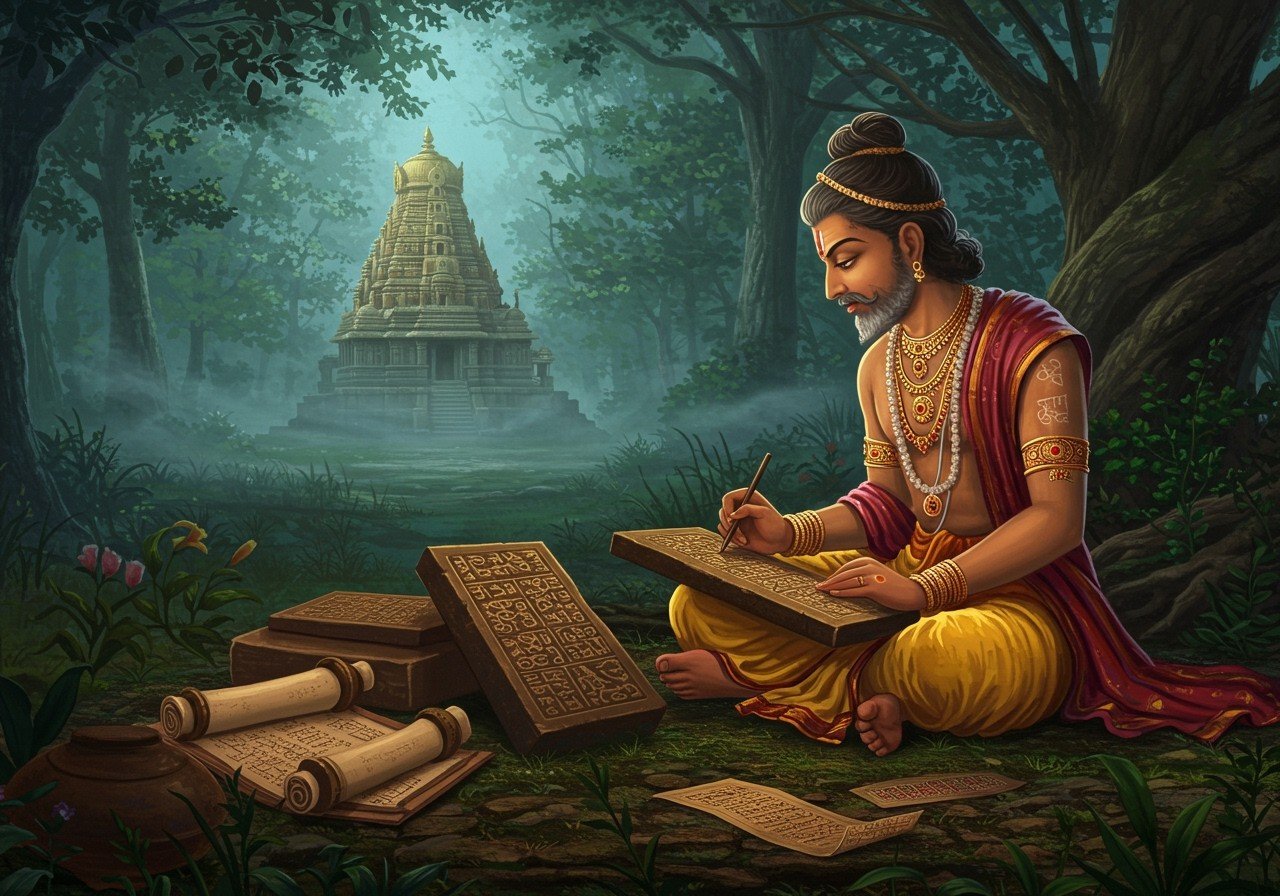
In the heart of Karnataka, in a quiet little village, lies a stone that speaks. It doesn’t use words we hear, but words that tell a story of our ancestors, our language, and our rich heritage. This is the story of the Halmidi Inscription, a precious key that unlocks a chapter of our past we thought was lost to time. For those of us who feel a deep connection to our roots, understanding such discoveries is like listening to the whispers of history itself.

A Discovery That Rewrote History
Imagine the year 1936. In the serene village of Halmidi in Hassan district, a remarkable discovery was made by Dr. M.H. Krishna, the then Director of Archaeology. He found a sandstone pillar, about 5 feet tall, with engravings on it. At first glance, it was just an old stone. But as he looked closer, he realised he had stumbled upon something extraordinary. This was not just any carving; it was the oldest known full-length inscription in the Kannada language, dating all the way back to around 450 CE!
For historians and lovers of culture, this was a moment of pure joy. The Halmidi inscription was proof that Kannada was not just a spoken language of the common folk back then, but was also used for official and administrative purposes by the ruling kings. It gives us a peek into the world of the Kadamba Dynasty, showing us how they governed and communicated.
What Does this Ancient Stone Tell Us?
So, what secrets are carved into this historic stone? The inscription, written in a very early form of Kannada often called Proto-Kannada, records a gift of land. It talks about a grant made to a warrior, showing the respect and rewards given to brave souls in those times. It’s a formal government record, much like the land deeds we have today, but from over 1500 years ago!
The script itself is a beautiful precursor to modern Kannada, with influences from the Brahmi script. It’s a wonderful example of how our languages have evolved over centuries, growing and changing with our people. This inscription is a testament to the administrative sophistication and cultural depth of early Karnataka. It’s a direct link to the social and political life of that era, far more personal than any history book.
The Cultural Tapestry of Ancient Karnataka
The time of the Halmidi inscription was a vibrant period in our history. The Kadamba rulers were great patrons of culture and religion. While this inscription focuses on administration, it existed in a world filled with devotion and art. Great temples were being conceived, and faith, primarily Hinduism and Jainism, was the bedrock of society. The stories of our gods and goddesses were being carved into stone, creating sacred spaces like the incredible Pataleshwar Caves, which echo the architectural genius of our ancestors.
Understanding this context helps us appreciate the inscription even more. It wasn’t created in isolation but was part of a thriving, spiritually rich society that valued both governance and God. This deep-rooted connection between our heritage and our faith is what keeps our traditions alive today.
The Enduring Legacy of the Halmidi Inscription
The discovery of the Halmidi inscription is a matter of immense pride for every Kannadiga and every Indian. It solidifies the ancient roots of the Kannada language and gives us a tangible piece of our glorious past. While it has long been celebrated as the oldest, it’s fascinating to know that our history is always being uncovered. Some scholars now point to the Talagunda inscription from 370 CE as an even earlier use of Kannada words, reminding us that there is always more to learn about our ancestors.
To honour this legacy, the Karnataka government has taken wonderful steps. The original stone is safely preserved, but a beautiful replica has been installed in a specially built *mantapa* in Halmidi village. This allows everyone to visit, connect with their history, and feel the weight of those ancient words. It’s a beautiful reminder that our heritage is not just for museums, but for all of us to experience and cherish.
Keeping Our Traditions Alive with Poojn.in
When we learn about such deep-rooted history, it often sparks a desire to connect more closely with our own traditions and rituals. Honouring our ancestors and our deities is a way of keeping this cultural flame burning bright. At Poojn.in, we understand this feeling completely. We are here to help you perform your pujas and rituals with items that are pure, authentic, and filled with reverence.
Whether you are setting up a small mandir at home and need a beautiful Marble Dust Shiva Murti, or you’re looking for all the essential Pooja Samagri for a special ceremony, we have everything you need. We believe that convenience should never come at the cost of tradition. With just a click, you can have authentic, high-quality cultural goods delivered to your doorstep, allowing you to focus on the devotion, not the details. For any help, you can always reach us at 03369029784 or on WhatsApp at 9476142738.
A Bridge to Our Past, A Guide for Our Future
The Halmidi inscription is more than just an archaeological find; it is a bridge that connects us to our past. It reminds us of the strength, wisdom, and resilience of our ancestors. It teaches us that our language and culture have a long and storied history, something to be incredibly proud of. By preserving and celebrating such treasures, we not only honour those who came before us but also ensure that this rich legacy continues to inspire generations to come. Let’s continue to explore these stories and keep our vibrant heritage alive in our hearts and homes.


